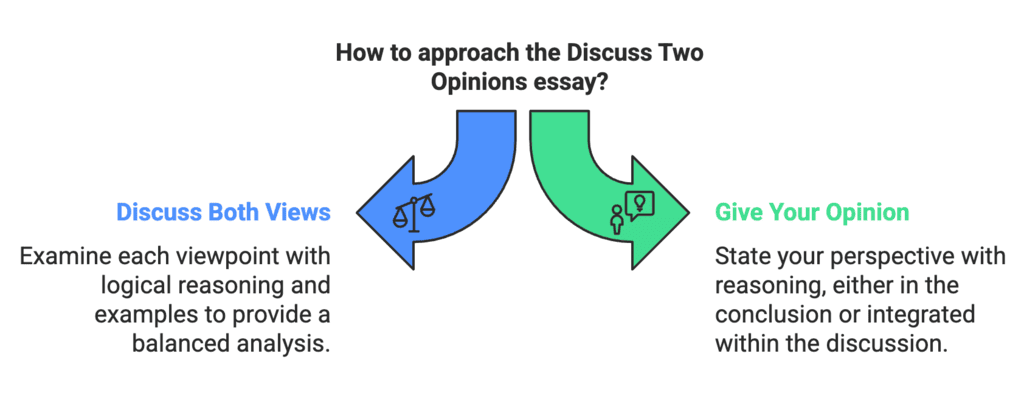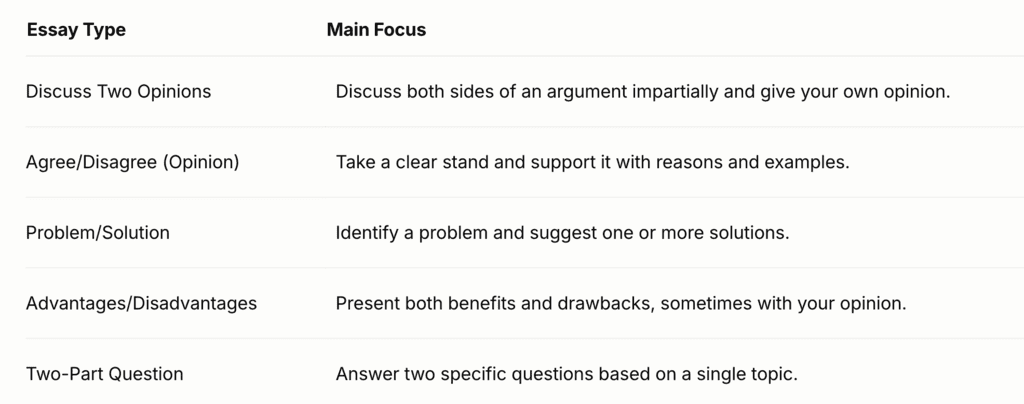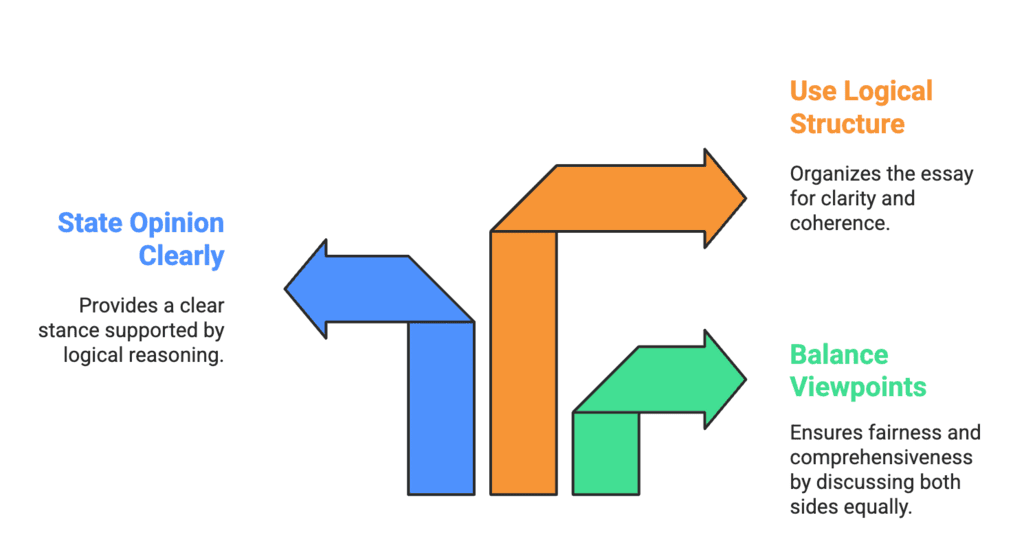How to Write an IELTS Task 2 Essay: Discuss Two Opinions Type | Solved Essays for IELTS PDF Download
The Discuss Two Opinions essay, also known as a Discussion Essay, is a common question type in IELTS Writing Task 2. In this essay, you are presented with two opposing viewpoints on a topic, and your task is to discuss both perspectives impartially, providing reasons and examples for each, before stating your own opinion. You are expected to explore both sides thoroughly and present a balanced argument, with your personal view typically expressed in the conclusion or integrated throughout. This essay is assessed not only on grammar and vocabulary but also on how clearly and logically you analyse both viewpoints and justify your opinion.
How to Approach the Discuss Two Opinions Essay?
Discuss Both Views: Examine the merits of each viewpoint with logical reasoning and relevant examples.
Give Your Opinion: State your own perspective, either in the conclusion or integrated within the discussion, supported by reasoning.

How Is It Different from Other IELTS Essay Types?
The Discuss Two Opinions essay differs from other essay types in key ways:

Unlike the Agree/Disagree essay, which focuses on defending your personal stance, the Discuss Two Opinions essay requires balanced exploration of both perspectives before presenting your view, ensuring impartiality in the discussion.
What to Keep in Mind When Writing This Type of Essay
Here are key strategies and points to remember:
1. Balance Both Sides
Discuss both viewpoints equally, providing clear reasons and examples for each.
Avoid favouring one side excessively unless your opinion strongly aligns with it.
2. State Your Opinion Clearly
Present your own view in the conclusion or subtly throughout the essay.
Ensure your opinion is supported with logical reasoning, not just stated.
3. Use a Logical Structure
A typical structure includes:
Introduction: Paraphrase the prompt and outline both views.
Body Paragraph 1: Discuss the first viewpoint with reasons and examples.
Body Paragraph 2: Discuss the second viewpoint with reasons and examples.
Conclusion: Summarise both views and state your opinion.

4. Support Your Arguments
Use specific examples, evidence, or scenarios to justify each viewpoint.
Avoid vague generalisations; aim for well-developed points.
5. Stay Formal and Academic
Use formal language, avoiding contractions (e.g., “do not” instead of “don’t”) and slang.
Employ linking words like “on the one hand,” “in contrast,” “furthermore,” and “in my view” to ensure smooth transitions.
6. Time Management
Spend 5 minutes planning, 30-35 minutes writing, and 5 minutes reviewing.
Ensure your essay is at least 250 words.
What the Question Looks Like
Here are typical Discuss Two Opinions prompts:
Some people believe that technology improves education, while others think it creates distractions. Discuss both views and give your own opinion.
Some argue that governments should prioritise public transport, while others believe private vehicles are more important. Discuss both views and give your opinion.
Some people think that young people should follow traditions, while others believe they should be free to choose their own path. Discuss both views and give your own opinion.
What the Examiner Expects
You are expected to:
Discuss both viewpoints impartially with logical arguments and examples.
Clearly state your own opinion, either in the conclusion or integrated within the essay.
Write at least 250 words in a formal, academic style.
Use effective paragraphing, linking devices, and a range of vocabulary and grammar.
Recommended Structure
Here’s a simple and effective 4-paragraph structure:
1. Introduction (40-50 words)
Paraphrase the prompt to introduce both viewpoints.
Briefly state that you will discuss both sides and provide your opinion.
Example:
Certain individuals argue that technology enhances education, whereas others believe it leads to distractions. This essay will discuss both perspectives before presenting my view that technology is beneficial when used appropriately.
2. Body Paragraph 1 - First Viewpoint (90-110 words)
Start with a clear topic sentence introducing the first opinion.
Explain the reasoning behind this view.
Provide a relevant example or evidence.
Example:
Advocates of technology in education argue that it provides unparalleled access to learning resources. Online platforms, such as educational apps and virtual libraries, enable students to study anytime, anywhere. For instance, platforms like Khan Academy offer free courses, making quality education accessible to students in remote areas, thereby enhancing learning outcomes.
3. Body Paragraph 2 - Second Viewpoint (90-110 words)
Present the opposing viewpoint with a clear topic sentence.
Explain and develop the reasoning for this perspective.
Include an example or illustration.
Example:
Conversely, critics argue that technology can distract students and hinder effective learning. The availability of social media and gaming apps often diverts attention from studies. For example, studies have shown that excessive screen time reduces students’ concentration, leading to lower academic performance, particularly when devices are misused in classrooms.
4. Conclusion (30-40 words)
Summarise both viewpoints briefly.
State your own opinion clearly, avoiding new ideas.
Example:
In conclusion, while technology offers significant educational benefits, it can also create distractions if not managed properly. In my opinion, technology improves education when used purposefully, provided measures are taken to minimise distractions.
Tips to Score High
Be Balanced: Discuss both viewpoints with equal depth to demonstrate impartial analysis.
Use Linking Words: Employ phrases like “on the one hand,” “in contrast,” “nevertheless,” “in my opinion,” and “to conclude” to enhance coherence.
Avoid Informal Language: Maintain a formal tone, avoiding slang or contractions (e.g., use “cannot” instead of “can’t”).
Plan Before Writing: Spend 3-5 minutes outlining both views and your opinion to ensure a logical structure.
Stay Within the Word Limit: Aim for 260-280 words to meet the minimum 250-word requirement without overwriting.
By following this structure and these tips, you can effectively address the Discuss Two Opinions essay, meeting the IELTS examiner’s expectations for a well-balanced, clearly argued response with a reasoned personal opinion.
|
16 videos|30 docs
|
FAQs on How to Write an IELTS Task 2 Essay: Discuss Two Opinions Type - Solved Essays for IELTS
| 1. What is a "Discuss Two Opinions" essay in the IELTS exam? |  |
| 2. How does a "Discuss Two Opinions" essay differ from other IELTS essay types? |  |
| 3. What should I keep in mind when writing a "Discuss Two Opinions" essay? |  |
| 4. What does a "Discuss Two Opinions" essay question look like? |  |
| 5. What does the examiner expect from a "Discuss Two Opinions" essay? |  |
















